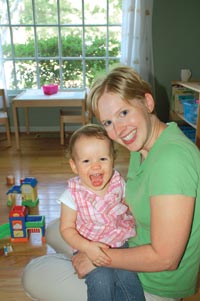
New mother Jennifer Remortel was grateful for the newborn hearing screening that determined her daughter, Evelyn, had no hearing problems.
Photo courtesy of NIH/NIDCD
"Yes!" says newborn hearing screening
At dawn on January 1, 2007, Evelyn Judith Remortel made her way into the world—to the delight of first-time parents Jennifer and Brian Remortel, of Montgomery Village, Md.
Beautiful as all babies are, was Evelyn healthy, too? To her parents' relief, she passed all her newborn tests, including screening for hearing. "You've just had this huge thing happen to you," recalls Jennifer. "Of all the unknowns, it was a big relief to know that her hearing was fine."
Although not universally required, newborn hearing screening has become common since 1993, the year the National Institutes of Health (NIH) recommended it for all infants within the first three months of life. There are two tests hospitals can use. One plays a sound in the baby's ears and records a return echo to indicate the baby can hear. The other uses earphones and electrodes to measure the baby's brain's response to sound.
Two to three of every 1,000 children born in the United States are deaf or hard-of-hearing. Research shows that early intervention with hearing devices and educational services can help children with hearing loss to develop language skills at the same rate as their hearing peers. Interventions are most effective for language development when the child is identified before age six months.
Researchers think that the first two years of life are the most important for developing language and speech. Discovered too late, children with hearing loss may face lifelong academic problems, struggle socially and have limited employment possibilities.
Today, about 81 percent of newborns are screened before they are one month of age, according to the National Institute on Deafness and Other Communication Disorders (NIDCD). Prior to this, the average age of identification for deaf and hearing impaired children was close to three years.
